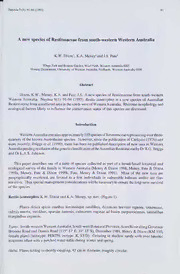Table Of ContentNuytsia9(1):91-94(1993) 91
A new species ofRestionaceae from south-western Western Australia
K.W. Dixon1 K.A. Meney'andJ.S. Pate2
,
'KingsParkandBotanicGarden,WestPerth,WesternAustralia6005
2BotanyDepartment,UniversityofWesternAustralia,Ncdlands,WesternAustralia6009
Abstract
Dixon, K.W.,Meney, K.A, and Pate,J.S. A newspeciesofRestionaceaefrom south-western
Western Australia. Nuytsia 9(1): 91-94 (1993). Restio isomorphus is a new species ofAustralian
Restionaceaefromarestrictedareainthesouth-westofWesternAustralia. Rhizomemorphologyand
ecological factors likely to influencetheconservation status ofthis species arediscussed.
Introduction
WesternAustraliacontainsapproximately 110speciesofRestionaceaerepresentingoverthree-
quarters ofthe known Australasian species. However, sincethepublication ofCarlquist(1976)and
morerecently, Briggs etal. (1990), there has been no published description ofnew taxain Western
AustraliapendingresolutionofthegenericclassificationoftheAustralianRestionaceaebyDrB.G. Briggs
and DrL.A.S. Johnson.
This paper describes one ofa suite ofspecies collected as part of a broad-based botanical and
ecological survey ofthe family in Western Australia(Meney & Dixon 1988, Meney, Pate & Dixon
1990a, Meney, Pate & Dixon 1990b, Pate, Meney & Dixon 1991). Most of the new taxa are
geographically restricted, are limited to a few individuals in vulnerable habitats and/or are fire-
sensitive. Thusspecialmanagementconsiderationswillbenecessarytoensurethelong-termsurvival
ofthespecies.
Restioisomorphus K.W. Dixon and K.A. Meney, sp. nov. (Figure 1)
Planta dioica spicis maribus femineisque similibus, rhizomate breviter repente, tomentoso,
culmis erectis, viridibus, sparsim ramosis; culmorum vaginae ad basim purpurescentes, lateralibus
marginibus expansis.
Typus: South-westernWesternAustralia,South-westBotanicalProvince,ScottRiveralongGovernor
BroomeRoad and Dennis Road (115° 17' E, 34° 15' S), December 1988, Meney& Dixon (KM 110,
female plant) (holotype: PERTH; isotype: K, SYD). Growing in shallow sandy soils over lateritic
ironstone often with aperched water-tableduring winterand spring.
Habit. Plants tuftingtoshortlycreeping, 45 cm indiameter, roughly circular.
92 NuytsiaVol.9,No. 1 (1993)
sFpiigkuerleet1(.xR5e)s;ti5o-ifseommaolrepfhluosw.er1o-pseknetecdhoouftp(lxa5n)t;(6x-0m.a25l)e;sp2ik-eslinegtl(ex5f)e;ma7le-cmuallemf(lx0o.w5e)r;o3pe-nseindgoluetm(axl5e);cu8l-mrh(xi0z.o5m);e4an-dfelmoawleer
culmbases(x0.5); 9-culmsheath(x2).
K.W.Dixon. K.A.MeneyandJ.S.Pate,Restioisomorphus 93
Rhizome elongated,variableinlength,2-3mmindiameter,denselyvillousonyoungrhizomesbut
weatheringwithage,withbroadlydeltoid,closelyappressedscaleleaves,0.3-0.4mmlong,glossyand
deciduous. Cataphylls 2-4,7-14mm long,straw-coloured, closelyappressed, chartaceous,acuteto
mucronate and persistent. Culms simple, glabrous, green flushed with purple at internodes, finely
striate,60-70cmtall, 1-1.2mmwide,erectandparallel,solid,chlorenchymaoftwolayersofpalisade
cells, stomatasuperficial. Culmsheaths 5-7, sterile and9-14fertileperculm, 1.5-2.1 cm long with
a 1-2mmlongoftendeciduousmucro,appressedatbasewithflaredlateralmargins,striate,scarious,
mm mm
purple grading tofawn towardsapex, persistent. Malespikeletserect, ovoid, 3-4 long, 2-3
wide,2-3persubtendinginflorescencebractonshort 1-2mmlongpedicels;subtendinginflorescence
bractbroadlyobovate,2-3mmlongwitha 1 mmlongmucro;lower 1-2glumesinfertile,upper 10-25
glumesfertile,glossy,coppery-bronzeaginggrey,marginsentire. Maleflowers sub-sessile;tepals5,
2outerand3 inner,2.5 mm long, linear-lanceolate,flat; marginspale,membranouswithrust-brown
tips,lateraltepalskeeled,glabrous,innertepalsslightlyshorterandbroader. Stamens3,stout,exserted,
pistallodeabsent. Femalespikeletserect,narrow-ovoidtoovoid,5-7mmlong,1-1.8mmwide,sessile;
bracts4, usually all fertile,sub-equal,keeled,red-brown, 3-5 mm longwitha 1 mm long mucroand
shortly fimbriate margins; spikelets solitary in upper 5-8 subtending inflorescence bracts, lower
inflorescence bracts often subtending 1.5-7 cm long branches each terminating in 3-6(8) single
spikelets;subtendinginflorescencebractssimilartothoseonmaleplants. Femaleflowers: tepals5(6),
linear-lanceolate,acute,3-3.5mmlong,paletohyaline,outertepalskeeledwithhairs,innertepalsonly
slightlykeeled andglabrous; stylered,dividedtobasewith two style branches, stigmawhite, ovary
bFirluoictulaarc,ap1sumlem, gwliodses,y,1.c2hemstmnultonbgr,ocwonmptoredsasrekdbwriotwhn,tw1o.8l-a2t.e0raml mraiwsieddes.utuSreeesd; ssmtaalmli,no1d.5esxa1bsmenmt,.
reniform, black, with whiteridges.
Floweringperiod. LateFebruary toApril; seeddehiscence: November-December.
Affinities.RestioisomorphusshowsaffinitywithRestio stenandra (BriggsandJohnsonined.)inplant
habit and spikelet morphology but is distinct in possessing superficially similar male and female
spikeletsandintheflaredpurpleandfawnculmsheaths. Thespeciesfavoursshallowwhiteorredsandy
soilsover lateritic ironstone whichisseasonally wet. Theculmsareerectandarisefrom a 1.5-2cm
deepsubsurfacemoreorlesscreepingrhizome. TherhizomemorphologyfitscategorytypeB3(Pate,
MeneyandDixon 1991)anddoesnotcontainstarch. Theplantsarekilledbyfireandregeneratefrom
seed. Theconservationstatusofthespecieswarrantsinvestigationasitisoflimitedlocaldistribution;
itsknownrangeislessthan5kmwiththeplantsconfinedtoironstonesoilswhicharepoorlyreserved
(only one small areaexists in ScottRiverNational Park).
Etymology. ThespecificepithetisderivedfromtheGreekisos,equal andmorphe, form,referringto
the similarmale andfemalespikelets.
Acknowledgements
We would like to acknowledge the considerable help and kind assistance provided to us by
DrLawrie Johnson and Dr Barbara Briggs of the Royal Botanic Gardens, Sydney and to thank
ProfessorWalterRossi,UniversityofFlorenceforprovidingtheLatindiagnosis. Wewouldalsolike
toacknowledgeMrGregKeighery,SeniorBotanist,DepartmentofConservationandLandManagement,
whoseoutstandingresearchintoplantbiogeographyinWesternAustraliahelpedbringtotheattention
ofmany botaniststherich anddiversefloraoftheScottRiverregion ofWesternAustralia.
94 NuytsiaVol.9,No. 1 (1993)
References
Carlquist,S.(1976). Alexgeorgea,abizarrenewgenusofRestionaceaefromWesternAustralia.Austral.J.Bot.24:281-95.
Johnson,L.A.S.andBriggs,B.G.(1990).ThespeciesofAlexgeorgea,aWesternAustraliangenusoftheRestionaceae.Austral.
Syst. Bot.3:751-8.
MeneyK.A.andDixonKW.(1988). Phenology,reproductivebiologyandseeddevelopmentinfourrushandsedgespecies
fromWesternAustralia. Austral J.Bot.36:711-26.
MeneyK.A.,PateJ.S.andDixonK.W.(1990a). PhenologyofgrowthandresourcedeploymentinAlexgeorgeanitens(Nees)
Johnson andBriggs(Restionaceae)- aclonalspeciesfromsouth-westWesternAustralia. Austral.!. Bot.38:543-57.
MeneyK.A..PateJ.S.andDixonK.W.(1990b). Comparativemorphology,anatomy,phenologyandreproductivebiologyof
Alexgeorgeaspecies(Restionaceae)fromsouth-westWesternAustralia.Austral J.Bot.38:523-41.
PateJ.S.,MeneyK.A.andDixonK.W.(1991).Contrastinggrowthandmorphologicalcharacteristicsoffire-sensitive(obligate
seeder)andfire-resistant(resprouter)speciesofRestionaceae(S. Hemisphererestiads)fromSouth-WesternAustralia.
Austral.J.Bot.39:505-25.

